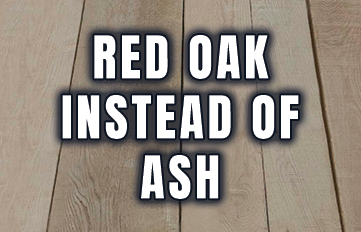For years we have been talking about the diminishing volumes of North American White ash (Fraxinus Americana) lumber. The impact the Emerald Ash Borer has had on the availability of trees to harvest cannot be understated. Today, the volumes of ash lumber we manufacturer is significantly lower. For comparison purposes, our ash production is approximately a third of what we manufacturer in red oak and less than both hard maple and soft maple. The primary reason is the reduced amount of trees to be  harvested.
harvested.
At one time, manufacturers might have considered ash as a replacement for red oak, especially when staining was part of their finishing process. This was due to the similar grain patterns of the two species and their working properties such as machining, gluing, and fastening being relatively the same. That is not as common today due to availability.
When it comes to Red oak you will find that is has a straight grain, coarse texture and is heavier in comparison to most hardwoods. It also grows plentifully in the eastern portions of the United States and Canada. Red oak is many times sought after based on its growing region.
Red oak that has been grown in the Northern and Appalachian regions (Quercus rubra) usually has a light pink/red color heartwood, tighter growth rings, and better color consistency. This makes it perfect for manufacturers that desire those “special” Red oak characteristics for their specific use.
Red oak grown in Southern regions (Quercus falcata) typically has a darker, red/brown coloration, and due to its longer growing season is more attractive to manufacturers that require longer average lengths and widths. This makes it a great fit for many of our millwork and moulding customers that require the longer lengths and widths for their production.
Those familiar with the hardwood lumber industry would tell you that hardwood lumber pricing is more like a commodities trading environment versus a consumer good. The pricing for ash and red oak vary frequently and are generally influenced by supply and demand. So, in today’s market it is not uncommon to see pricing for ash be higher than red oak lumber in certain grades and thicknesses.
If you are considering ash, red oak or any other species of hardwood lumber and would like to discuss options and alternatives give any member of The Baillie Group a call! We would welcome the chance to help you.
Tony Cimorelli
Baillie

